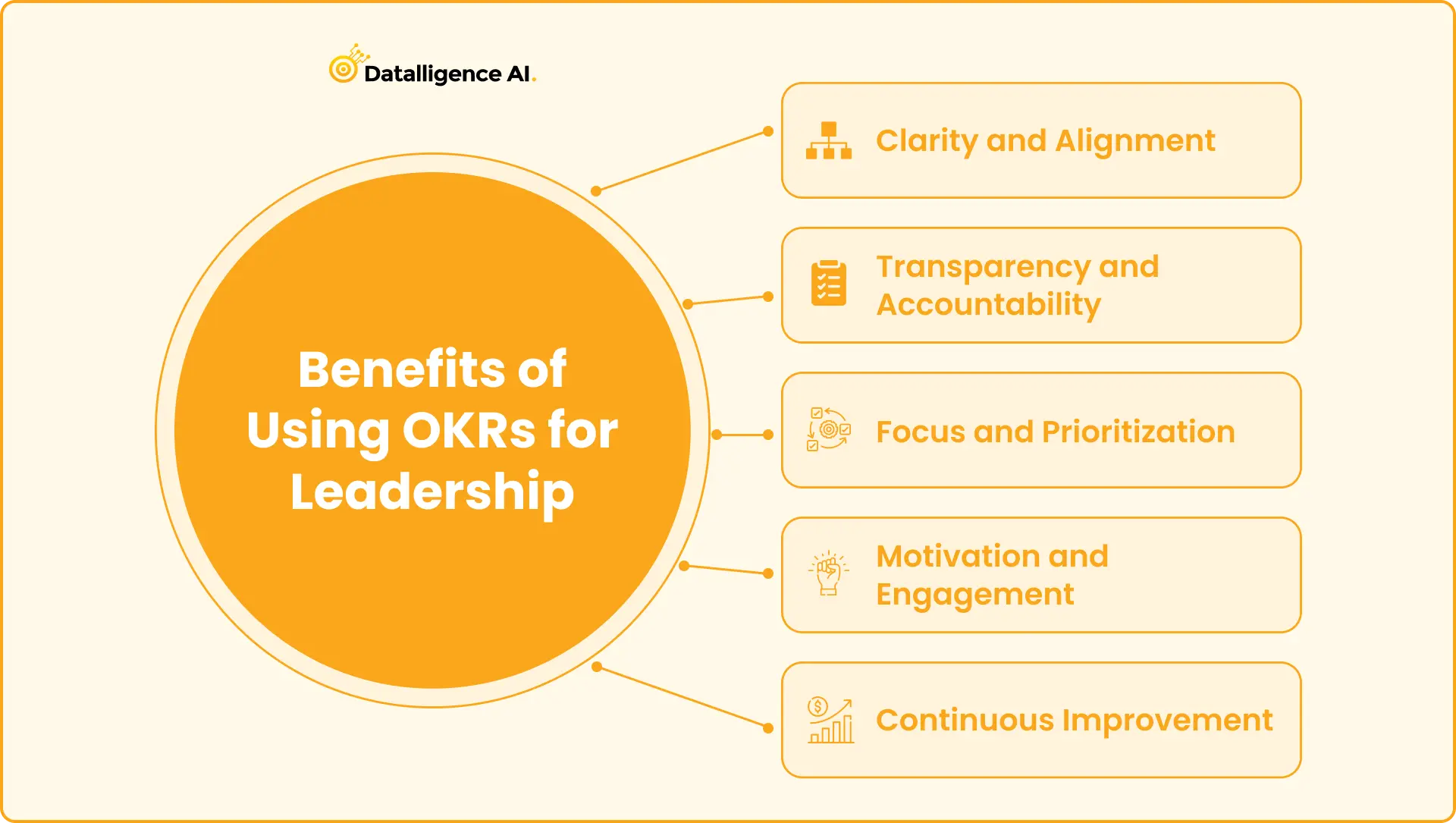In today’s rapidly evolving business landscape, effective leadership is crucial for driving success and achieving organizational goals. One proven method that leaders can utilize to align their teams and drive performance is the implementation of Objectives and Key Results (OKRs). This goal-setting framework provides leaders with a transparent and measurable approach to set clear goals and track progress.
In this comprehensive guide, we will explore the benefits of using OKRs for leadership and provide a wide range of practical examples for different management roles and teams. Whether you are a CEO, Director of Operations, or a team leader, these leadership OKR examples will inspire you to set ambitious yet achievable goals that motivate your team and drive success.
Table of Contents
Benefits of Using OKRs for Leadership

Implementing OKRs in leadership roles offers several benefits for both leaders and their teams. Let’s delve into some of the key advantages:
- Clarity and Alignment: OKRs provide a clear and concise framework for leaders to communicate their objectives and align their teams with the company’s mission and vision. By setting specific goals, leaders can ensure that everyone is working towards a common purpose.
- Transparency and Accountability: OKRs promote transparency by making goals and progress visible to the entire organization. This transparency fosters accountability, as team members are aware of their contributions and can track their progress toward key results.
- Focus and Prioritization: With OKRs, leaders can prioritize the most critical objectives and key results, ensuring that teams are working on the most impactful tasks. This focus helps minimize distractions and ensures that efforts are directed toward achieving the desired outcomes.
- Motivation and Engagement: Setting ambitious yet achievable goals using the OKR framework can motivate and inspire teams to reach higher levels of performance. When employees understand how their work contributes to the overall objectives, they feel more engaged and motivated to succeed.
- Continuous Improvement: OKRs provide a feedback loop that allows leaders to assess progress, identify areas for improvement, and make necessary adjustments. This iterative process encourages continuous learning and growth within the organization.
Leadership OKR Examples
Now, let’s explore a wide range of leadership OKR examples for different management roles and teams. These examples will help you understand how to structure your objectives and key results effectively to drive success.
CEO OKR Examples
Example 1: Driving Revenue Growth
Objective: Increase annual revenue by 20% to drive business growth.
- KR 1: Achieve a 25% increase in new customer acquisition.
- KR 2: Increase upsells and cross-sells by 15% to existing customers.
- KR 3: Improve customer retention rate by 10%.
Example 2: Enhancing Leadership Development
Objective: Develop a strong leadership team to drive organizational success.
- KR 1: Conduct leadership training programs for all managers and executives.
- KR 2: Implement a mentorship program to foster leadership growth and development.
- KR 3: Increase employee satisfaction with leadership by 15%.
To learn more about CEO OKR Examples, Visit our Blog Best OKR Examples for CEO
Director of Operations OKR Examples
Example 1: Improving Operational Efficiency
Objective: Streamline operations to improve efficiency and reduce costs.
- KR 1: Reduce overall operational costs by 10% through process optimization.
- KR 2: Increase productivity by implementing automation tools and technologies.
- KR 3: Improve customer satisfaction ratings for operational processes by 20%.
Example 2: Ensuring Regulatory Compliance
Objective: Maintain strict adherence to regulatory requirements.
- KR 1: Conduct regular audits to ensure compliance with industry regulations.
- KR 2: Implement training programs to educate employees on compliance standards.
- KR 3: Achieve a 100% pass rate in external regulatory audits.
To learn more about Operations OKR Examples, Visit our Blog 6 Best OKR Examples for Operations
Director of IT, Digital Transformation OKR Examples
Example 1: Driving Digital Transformation
Objective: Implement digital transformation initiatives to improve operational efficiency.
- KR 1: Develop and launch a new customer relationship management (CRM) system.
- KR 2: Increase website traffic by 30% through digital marketing strategies.
- KR 3: Enhance cybersecurity measures to reduce the risk of data breaches by 50%.
Example 2: Enhancing IT Infrastructure
Objective: Upgrade and modernize IT infrastructure to support business growth.
- KR 1: Migrate legacy systems to cloud-based platforms to improve scalability.
- KR 2: Implement a disaster recovery plan to ensure business continuity.
- KR 3: Reduce IT support response time by 20% to improve employee productivity.
Team-Specific Leadership OKR Examples
Human Resources OKR Examples
Example 1: Employee Engagement and Retention
Objective: Foster a positive work environment and improve employee retention.
- KR 1: Increase employee engagement survey scores by 10%.
- KR 2: Reduce employee turnover rate by 15% through targeted retention strategies.
- KR 3: Implement professional development programs to enhance employee skills.
Example 2: Diversity and Inclusion
Objective: Promote diversity and inclusion within the organization.
- KR 1: Increase the representation of underrepresented groups in leadership positions by 10%.
- KR 2: Implement unconscious bias training for all employees.
- KR 3: Create employee resource groups to foster an inclusive work environment.
To learn more about HR OKR Examples, Visit our Blog 10 Best HR OKR Examples
Marketing OKR Examples
Example 1: Brand Awareness
Objective: Increase brand awareness and recognition in the market.
- KR 1: Increase social media followers by 20% through targeted marketing campaigns.
- KR 2: Improve website traffic by implementing search engine optimization (SEO) strategies.
- KR 3: Achieve a 15% increase in brand mentions and media coverage.
Example 2: Lead Generation
Objective: Generate high-quality leads to drive sales growth.
- KR 1: Increase lead conversion rate by 20% through targeted lead nurturing campaigns.
- KR 2: Generate a 30% increase in organic website traffic through content marketing efforts.
- KR 3: Improve the quality of leads by implementing lead-scoring methodologies.
To learn more about Marketing OKR Examples, Visit our Blog Top 10 OKR Examples For Marketing Team
Sales OKR Examples
Example 1: Revenue Growth
Objective: Achieve revenue growth targets and increase market share.
- KR 1: Increase sales revenue by 25% through effective sales strategies.
- KR 2: Expand customer base by 15% through targeted prospecting and lead generation.
- KR 3: Achieve a 20% increase in average deal size through upselling and cross-selling.
Example 2: Sales Team Performance
Objective: Improve sales team performance and productivity.
- KR 1: Increase the average number of sales calls per representative by 20%.
- KR 2: Achieve a 15% increase in sales team quota attainment.
- KR 3: Implement sales training programs to improve product knowledge and selling skills.
To learn more about Sales OKR Examples, Visit our Blog 10 Best Sales OKR Examples
Information Technology OKR Examples
Example 1: IT Security and Risk Management
Objective: Enhance IT security measures and mitigate risks.
- KR 1: Conduct regular vulnerability assessments and reduce critical vulnerabilities by 50%.
- KR 2: Achieve a 100% compliance rate with industry security standards.
- KR 3: Implement a robust data backup and recovery system to minimize the impact of potential data breaches.
Example 2: IT Service Delivery
Objective: Improve IT service delivery to support business operations.
- KR 1: Achieve a 90% customer satisfaction rating for IT support services.
- KR 2: Reduce average response time for IT support tickets by 20%.
- KR 3: Implement self-service IT support tools to empower employees and improve efficiency.
To learn more about IT OKR Examples, Visit our Blog 12 Best OKR Examples for IT Department
Key Metrics for Tracking Leadership OKRs
Tracking key metrics is essential for measuring the progress and success of your leadership OKRs. Some key metrics to consider include:
- Revenue Growth: Measure the increase in revenue achieved through your OKRs.
- Customer Satisfaction: Monitor customer satisfaction metrics, such as Net Promoter Score (NPS) or customer feedback ratings.
- Employee Engagement: Track employee engagement metrics, such as employee satisfaction surveys or retention rates.
- Market Share: Measure the growth of your market share compared to competitors.
- Productivity: Monitor productivity metrics, such as output per employee or team efficiency.
Conclusion
Setting and achieving goals is an integral part of effective leadership. By implementing the OKR framework, leaders can align their teams, set clear objectives, and drive success. The provided leadership OKR examples demonstrate how objectives and key results can be structured for different management roles and teams.
Remember, successful OKR implementation requires clarity, transparency, and continuous improvement. By leveraging the benefits of OKRs, leaders can inspire their teams, foster engagement, and achieve remarkable results. So, embrace the power of OKRs and lead your organization toward greater success.
At Datalligence.AI, we understand the importance of setting and achieving goals. Our AI-powered OKR software can help streamline the OKR process, enhance collaboration, and provide valuable insights to drive your leadership initiatives. Take your leadership to the next level with Datalligence AI.











